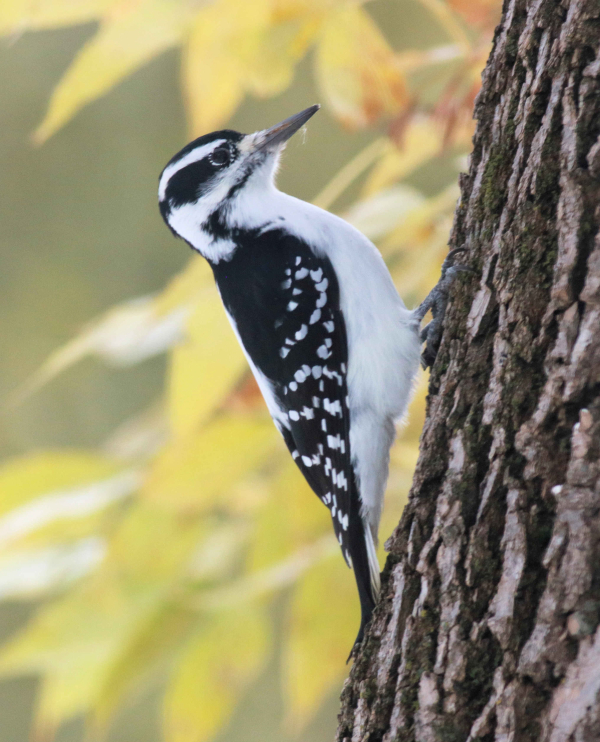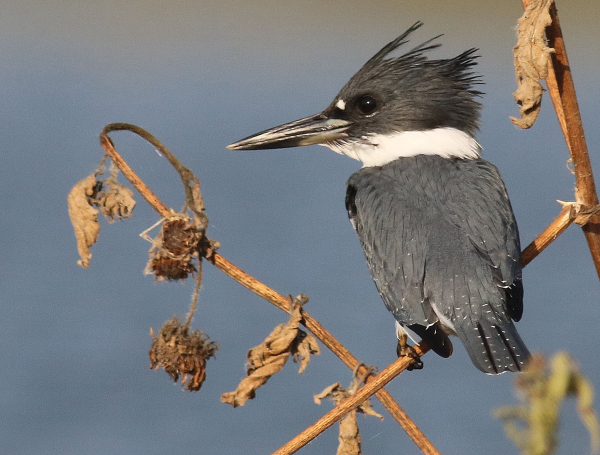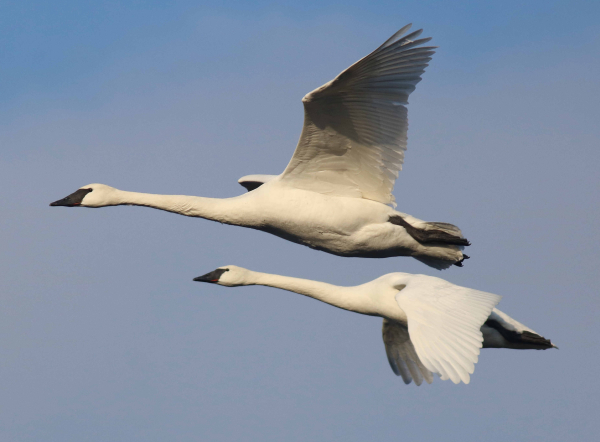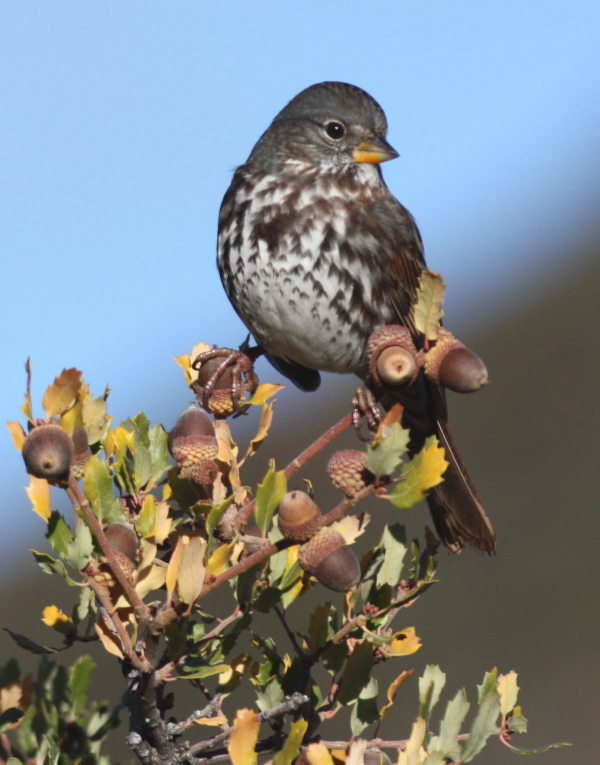The advent of the fall birding season provides a lot of excitement and enthusiasm with plenty of photography potential and possibilities; some that will be fulfilled this week, others in weeks and months ahead. Already, early migrants are evident, and they will increase in numbers and variety weekly. From raptors to hummingbirds, songbirds to sandpipers, and wading birds to waterfowl, there are great photo opportunities for birders throughout the autumn season.

Colorful leaves can add a lot to a photo of a black and white Hairy Woodpecker, and any other birds. It’s an autumn option.
|
Fall flights include many more birds than spring migration with the addition of recently fledged young birds, that are often more trusting than adult birds; plus you should be able to document some family groups, as well as adults in basic plumage. You will enjoy lots of surprises along the way as new species pass through and new flocks stop over to feed and rest for extended periods. It gets me excited just thinking about the possibilities as I recall past experiences.
Realistically, successful fall bird photography all comes down to photo basics to get the best results from the photo ops that present themselves during fall. We need to be aware of and take advantage of lighting, timing, settings, flights, autumn colors, and more. It’s always worth reviewing the basics so when you’re in the field, you give them a second thought, until the basics become second nature in your bird photography. Let’s get started with a point by point review of some things to keep in mind this fall:
– Always have your camera with you; have it with you when you’re in your vehicle, and while you’re in your house or apartment. Put your camera in an unassuming backpack or another option, and keep it close at hand – just in case. You can’t take a photo of an interesting bird if you don’t have your camera ready and within reach.
– Keep the sun at your back, so the sunlight illuminates your subject directly.
– The best photo time is during morning and late afternoon, when the sun is at a 30- to 60-degree angle above ground level. This means avoiding midday hours when the sun is overhead – now – but with the advance of fall, the sun becomes positioned ever-farther south in the sky, which will provide more hours of prime sun angles and prime photography light.
– If it’s cloudy, I usually do something else – birding with binoculars, for example – rather than with my camera. (I still have my camera with me in case a Mountain Lion or Sasquatch appears.) Sunlight provides better, brighter colors, contrast, and details with faster shutter speed options. Watch the weather forecast to plan your photo time when the sunlight is best – or just look out a window and assess your options according to the current weather and the sun’s position.
– The time of the day will also dictate some bird activities, such as feeding and loafing periods for flocks of geese and ducks, songbirds, and others.
– This fall, emphasize taking photos of birds in autumn settings with colorful leaves and golden grasses.

Although not as colorful, dried plants also add a seasonal touch to photos of birds like this Belted Kingfisher.
|
– Occasionally, try covering a larger area than usual to monitor your favorite migration hotspots and other locations where birds are perching, feeding, and congregating. Take advantage of photo ops you encounter along the way, and plan for future photo opportunities by assessing the best time of day to return with respect to the direction of sunlight.
– Take advantage of photographing in a variety of habitats in your area – wetlands, woodlands, grasslands, city parks, neighborhood landscaping, and others.
– Focus on an eye of the bird you are photographing. If the eyes are in focus, the rest of the bird should be too.
– Stabilize yourself the best way you can when photographing. You can lean against a tree, structure, vehicle, etc.; but if that’s not possible, while holding your camera and lens in your hands, pull your elbows against your chest, which will help to stabilize your camera.
– Hold your breath just before and while you press the shutter button.
– Try to anticipate the next move of the birds you photograph, although that is usually easier said than done. Be aware that if you are reacting to what a bird is doing, by the time you react and press the shutter button, the bird may move or complete any action you are trying to document.
– In some cases, it’s good to get low; get closer to the birds’ level if they are swimming or feeding on the ground. Bend down, kneel, lay down if you can; it will provide a nice change of perspective on some of your bird photos.
– As you compose photos, occasionally make an effort Not to position your subject in the center of the photo frame. When possible, try positioning the bird to one side; give it space to look into, walk into, or run or fly into. Sometimes, you can reposition your subject during a photo edit, when you can rethink the positioning of the bird in the cropping frame.
– Try your best to avoid impacting birds you wish to photograph. Try not to disturb them or press them into flight, especially if they are feeding or hunting. The well-being of the birds we observe and photograph is paramount.
Mobile Basics

Fall can be the best season to photograph waterfowl in flight, such as these majestic Trumpeter Swans.
|
– You can use your vehicle as a means of exploring and monitoring favorite birding areas or routes.
– Utilize your vehicle as a comfortable “mobile blind.” When you find a bird or flock of birds, pull safely off the side of the road in the best possible position to photograph, always with respect to the direction of the sunlight.
– Turn off the vehicle any time you are photographing to keep your camera lens as stable as possible.
– Stabilize your lens on top of a slightly raised window or the side of an open window frame to reduce any body shake that may be transferred as you hold your camera. Also hold your breath when you press the shutter button.
– It’s almost always best not to get out of your vehicle when photographing. Birds and other animals tend to react to such activity by fleeing. Wildlife tend to be more trusting of a stationary vehicle more than they are of a moving person.
– Safety is paramount at all times when you’re in a vehicle, whether it’s moving or stopped. Be sure you aren’t impacting other drivers, and that your vehicle will not create a distraction for other drivers. Be aware not to stop or park below the crest of a hill where you may not be obvious to vehicles following from behind. Always monitor any traffic behind you, and even though a bird may surprise and excite you, be careful not to stop short when other vehicles are following. Simple points perhaps, but worth mentioning in the name of safety.
Tech Checks
– I suggest setting the Mode Dial on your camera to Av (aperture preference). Then, when you dial your aperture (f-stop), the camera automatically provides the associated shutter speed, depending on the amount of available light. (I would never suggest using an automatic setting.)
– On a sunny day, it’s best to preset your camera; then when you’re in position to photograph a bird, take a couple photos before double-checking the settings and adjusting any. During sunny days, I preset the ISO to 400, the aperture at f8; and the resulting shutter speed will usually be automatically set between 1/1200 to 1/2000 (of a second) – fast enough to stop most motion.

A Fox Sparrow is featured atop a fall spray of scrub oak leaves and acorns. This impressive native sparrow belongs to the western Slate-colored subspecies of Fox Sparrow. The variety of fall photo potential is vast and exciting – Good Luck!
|
– Set your camera to the Continuous Shooting mode, which allows you to take a series of photos by holding down the shutter button for number of seconds. For example, when birds are flying, or are especially active, you can hold the shutter release button down to allow the camera to take a continuous series of images at a rate of 3 to 20+ photos per second, depending on what camera model you have. A series of photos permits you to choose the best one, or a few.
– When a bird is in a location with a less than pleasing background, try to blur the background into a fairly uniform color by using an aperture of f5 or f6 to limit the field of focus. This works best when the background is widely separated from the bird.
– Conversely, in some cases you may want to expand the field of focus to show the surroundings – fall leaves perhaps - especially if this treatment adds quality to the background. In that case, try an aperture of f11 or f14, for example, as long as you can keep a fast enough shutter speed of 1/400 or faster.
Learning Through Experience & Repetition
– We all learn best through experience, and experiences, so the more time you devote to bird photography, the better photographer you will become. Mere repetition will make many aspects of bird photography second nature, and with each photo session you have with willing birds your photos are sure to improve.
– And then there is the luck factor, and that’s especially true with wildlife photography and especially when birds are involved. Some would say we make our own luck, and that’s true too; we get lucky when we have our camera in hand, when we spend the time, when we visit prime locations. Then again, when you’re interacting with birds that can fly, it adds another dimension to the idea of luck – whether a bird appears via flight, chooses to take flight, or provides an aerial performance to photograph, it all adds a level of excitement and potential of bird photography.
Today, our digital cameras are so advanced that we can rely on their exceptional technical qualities, which permits us to concentrate on real bird photography. Bird photography can be the aspect of birding that provides the greatest rewards and most exciting encounters with birds. Take advantage of the fall season as often as possible and reap a bountiful harvest of fall bird photos along the way.
Article and photographs by Paul Konrad
Share your bird photos and birding experiences at editorstbw2@gmail.com